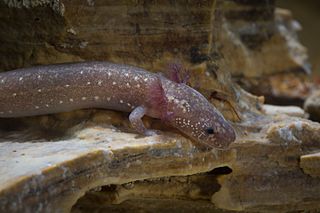
The Barton Springs salamander is an endangered lungless salamander. It is endemic to Texas, United States. It was first found in Barton Springs in Austin, but is now also known from other localities in the nearby Travis and Hays Counties. Barton Springs is located within Zilker Park which is situated in the Edwards Aquifer in Austin, Texas. Eliza Springs, located within Barton Springs, has one of the largest populations of Barton Springs salamanders.

The olm or proteus is an aquatic salamander which is the only species in the genus Proteus of the family Proteidae and the only exclusively cave-dwelling chordate species found in Europe; the family's other extant genus is Necturus. In contrast to most amphibians, it is entirely aquatic, eating, sleeping, and breeding underwater. Living in caves found in the Dinaric Alps, it is endemic to the waters that flow underground through the extensive limestone bedrock of the karst of Central and Southeastern Europe in the basin of the Soča River near Trieste, Italy, southwestern Croatia, and Bosnia and Herzegovina. Introduced populations are found near Vicenza, Italy, and Kranj, Slovenia. It was first mentioned in 1689 by the local naturalist Valvasor in his Glory of the Duchy of Carniola, who reported that, after heavy rains, the olms were washed up from the underground waters and were believed by local people to be a cave dragon's offspring.

Brook salamanders are a genus, Eurycea, of salamanders native to North America.
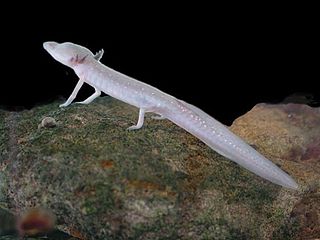
The Texas blind salamander is a rare and endangered cave-dwelling troglobite amphibian native to San Marcos, Hays County, Texas, specifically the San Marcos Pool of the Edwards Aquifer. This species resembles the olm, another stygofaunal salamander from Europe. Unlike the olm, this amphibian's body is not as elongated, and also has less reduced digits on its limbs.

Troglofauna are small cave-dwelling animals that have adapted to their dark surroundings. Troglofauna and stygofauna are the two types of subterranean fauna. Both are associated with subterranean environments – troglofauna are associated with caves and spaces above the water table and stygofauna with water. Troglofaunal species include spiders, insects, myriapods and others. Some troglofauna live permanently underground and cannot survive outside the cave environment. Troglofauna adaptations and characteristics include a heightened sense of hearing, touch and smell. Loss of under-used senses is apparent in the lack of pigmentation as well as eyesight in most troglofauna. Troglofauna insects may exhibit a lack of wings and longer appendages.

The Cascade Caverns salamander, or Cascade Caverns neotenic salamander, is a species of aquatic salamander endemic to Cascade Caverns in Kendall County, Texas. Like other species of cave salamanders, they are almost entirely subterranean, living in spring waters deep in limestone rock strata, so gauging the exact extent of their geographic range or even their population numbers is virtually impossible. This also leads to reduced sampling for study, which has led to some uncertainty in the taxonomic classification; some sources consider all species of Texas cave salamanders to be subspecies of the Texas salamander. Eurycea neotenes and Eurycea rathbuni also live in caves and eat small insects and spiders.

The Valdina Farms salamander is a species of aquatic salamander described from Valdina Farms Sinkhole in Medina County, Texas, United States. It is sometimes referred to as the Valdina blind salamander or sinkhole salamander. As some other species of Eurycea found in Texas, it was once classified as a subspecies of the Texas salamander, Eurycea neotenes, and believed to possibly be the result of hybridization with another species of subterranean salamander, but was granted full species status in 2000. Research is ongoing, and some sources suggest the current species may actually be multiple distinct species.

The San Marcos salamander is a small species of aquatic, lungless salamander native to the United States, endemic to Spring Lake and a small region of the headwaters of the San Marcos River near Aquarena Springs, in Hays County, Texas. It is one to two inches long, with a slender body and external gills, and is reddish-brown in color.
The Comal blind salamander or Honey Creek Cave blind salamander is a small species of aquatic, lungless salamander native to the United States. It is endemic to a small region at the junction of Comal, Bexar and Kendall Counties in Texas. It is 1.5 to 3.0 in long, with a slender body and external gills, and is an overall translucent pink color.
The Blanco blind salamander is a species of aquatic, lungless salamander native to the United States. It is endemic to a small region of the Blanco River near San Marcos in Hays County, Texas. Its habitat, deep in limestone karst, makes collecting specimens for research particularly problematic. It is known from only a single specimen, collected in the 1950s.
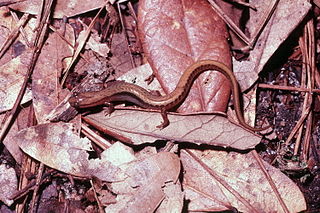
The southeasterndwarf salamander, formerly known as the dwarf salamander, is a species of salamander native to the southern United States, ranging primarily from southern North Carolina south to northern Florida, with some populations from southwestern Alabama to eastern Louisiana. Some sources refer to it as the four-fingered manculus, dwarf four-toed salamander, or the Florida dwarf salamander.
The spring cavefish is the only member of the genus Forbesichthys and is one of seven species in the family Amblyopsidae. This species is listed as state endangered in Missouri, but it is considered to be of least concern by the IUCN Red List due to its relatively large population size and number of subpopulations. The spring cavefish inhabits caves, springs, spring runs, and spring seeps. It is subterranean, emerging at dusk and retreating underground an hour or two before dawn. The species is located within areas of the central and southeastern United States. It stays underground after dawn, but then emerges into surface waters at dusk. They are a carnivorous fish and are well adapted to their environment. The species' breeding behavior is rarely documented. Spawning occurs underground and in darkness between January and April. The status and distribution of cave-obligate species is incomplete or lacking entirely, which makes conservation and management decisions difficult. Kentucky and Missouri are the two main states that have their agencies managing this species in some way.

The northern two-lined salamander is a species of salamander in the family Plethodontidae found in Canada and the United States. Its natural habitats are temperate forests, temperate shrubland, rivers, intermittent rivers, freshwater marshes, freshwater springs, arable land, and urban areas. It is more water-oriented than the related northern redback salamander, and can often be found in and around water such as rain puddles, streams, swamps, and damp stream beds, whereas the northern redback tends to be found in damp ground, but usually not near open water.

The Georgetown salamander, also known as the San Gabriel Springs salamander, is a species of salamander in the family Plethodontidae. It is endemic to springs in Williamson County, Texas, near Lake Georgetown. It inhabits freshwater springs and, possibly, caves. It is threatened by habitat loss. Many of the springs where this species formerly lived have been destroyed by development, including creation of Lake Georgetown. The specific name refers to the few remaining remnants of habitat for this species.
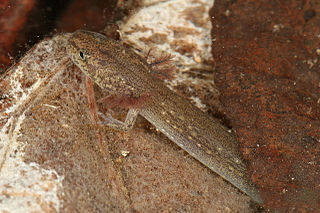
The Jollyville Plateau salamander is a species of salamander in the family Plethodontidae. It is also known as the Tonkawa Springs salamander. It is endemic to Travis and Williamson counties, Texas, United States. This species is perrenibranchiate, retaining its gills throughout life.

The western grotto salamander, also called the Ozark blind salamander and previously known as just the grotto salamander, is a species of salamander in the family Plethodontidae. It is endemic to the United States. Its natural habitats are freshwater springs, inland karsts, and caves. It is not currently threatened, but vulnerable to changes in groundwater quality and reduction in bat population.

Cambarus cryptodytes, the Dougherty Plain cave crayfish or Apalachicola cave crayfish, is a small, freshwater crayfish endemic to Florida and Georgia in the United States. It is an underground species known only from waters associated with the Floridan aquifer.
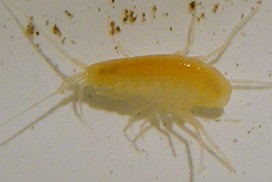
Stygobromus pecki, the Peck's cave amphipod, is a rare species of crustacean found in four cavern areas of southwestern Texas in the United States. It is a federally listed endangered species in the United States and is also listed as Endangered on the IUCN Red List. Because of the species' limited geographical distribution, not much information on S. pecki is known. As of April 2022, there is no available 5-year review, Species Status Assessment, or recovery plan for the species. However, the Edwards' Aquifer Habitat Conservation Program (EAHCP), with the support of the U.S. Fish and Wildlife Service (UFWS), has been attempting to further study and promote conservation of S. pecki.
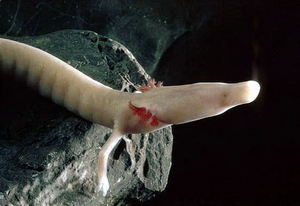
A cave salamander is a type of salamander that primarily or exclusively inhabits caves, a group that includes several species. Some of these animals have developed special, even extreme, adaptations to their subterranean environments. Some species have only rudimentary eyes. Others lack pigmentation, rendering them a pale yellowish or pinkish color.
















